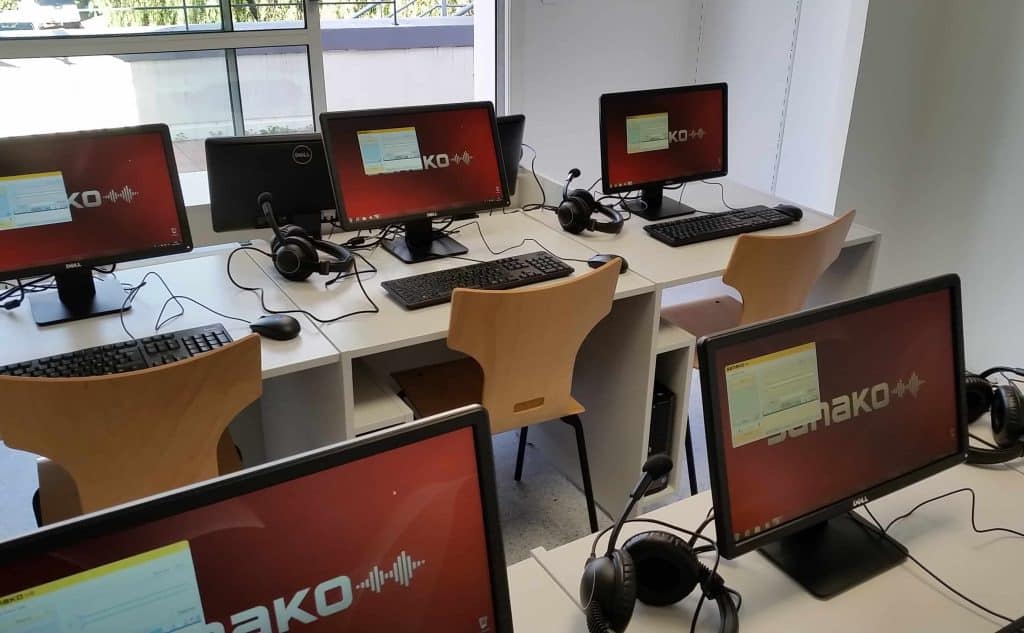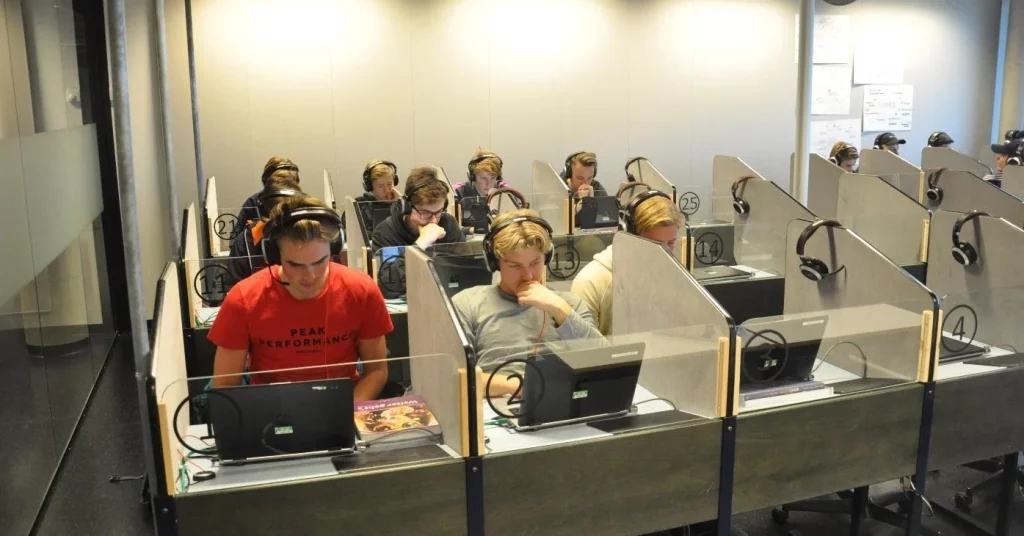We’re thrilled to repost one of our classic blog posts! This old gem about language labs has now been revamped to reflect the latest changes in language teaching and learning technology over the past few years. This blog post was originally published in 2020 and was last updated on October 4, 2023.
Introduction to language labs
Modern language labs are known by many names, digital language lab, foreign language lab, English language lab, multimedia language lab, language media center, and multimedia learning center to name but a few. These various names usually refer to the same concept of using a dedicated language teaching system to teach new languages.
A language laboratory (or language lab in short) is a system that transforms a passive language class into an active speaking-based learning environment. This helps the language teacher to save a substantial amount of time and manage their language classes more efficiently. For students this means that they can spend more time on speaking-based language learning activities and actually using the target language. Usually when using language laboratories, the teaching focus shifts to using audio-visual teaching aids instead of teaching the second language through text-books and grammar rules.
The language lab system itself is language agnostic and the target language is determined by the chosen teaching material which can obviously be English, Spanish, French, Chinese, Russian, German or which ever teaching material the school/teacher has available for them.
The language lab concept has been the most prominent application to use technology to enhance English and foreign language teaching methods in our formal education sector. This technology-enhanced language teaching environment tends to be more effective than a traditional text-book or lecture based class – especially when using communicative language teaching strategies which aim to develop students oral language proficiency and listening skills.
Watch below Sanako’s old but classic “What is a language lab” video explaining more about language labs and how schools and universities can benefit from this language teaching and learning technology.

How modern language labs are used in language teaching?
When some of us think of a language lab, we easily visualise a dedicated classroom that has separate sound booths for each student and purposely built “language lab equipment” installed on each desk. This is exactly how previous generation language lab systems used to work but modern language lab tools have evolved a lot since these days. The modern language lab most often is a normal everyday classroom without any dedicated sound booths and the students are connected to their teacher and peers using their laptops or mobile devices.
Some of the ways teachers can use language labs are listed below:
-
In a language lab, teachers can use engaging language learning content and resources. For example text, images, audio and video can easily be integrated into teaching and learning languages and language teachers can alter learning materials to fit their requirements and curriculum.
-
It allows important self-evaluation for students. Students can record their own voice and play back the recordings, interact with each other and the teacher, and store their results and recordings. This collaborative nature usually increases students’ motivation and their learning experience.
-
The teacher has better tools to manage the classroom and observe each individual student. Language teachers can intervene and control the learners’ computers, join into group discussions, listen to each individual student, track of learners’ work, etc.
-
Expands the capabilities of the whole language learning program by allowing self-access for independent learning which includes access to language learning resources outside class.
The purpose of a language lab is to involve students to actively participate in language learning exercises and get more practice time than otherwise would be possible in a traditional classroom environment. The main benefit of a language lab is that it increases the time each student can spend actively speaking and practicing during the class. It has been noted that developing students’ oral proficiency and speaking fluency is a common problem in our formal language education. This is the reason why most traditional language learning programs fail to make our students fluent. Language labs and similar language teaching and learning technology tools solve this problem efficiently.
What are the components and equipment in a language lab?
- Teacher has a computer or a laptop with appropriate software for conducting language classes and assigning language learning activities for students.
- If the teaching takes place in a physical classroom or in the school’s computer lab, then the teacher and students usually wear language learning headsets that block outside sounds and disturbances.
- Students’ side of the language lab software provides the students a media player for listening to audio materials and recording tools for recording their speech and pronunciation.
- Teacher and student positions are connected via LAN (local area network) if they are using a desktop language lab software, like Sanako Study 1200, and via Internet if they are using modern browser based tool like Sanako Connect.
You can find some commonly asked questions (and answers!) about language labs from our other post here: “Commonly asked questions about language labs“.
Below is a picture from a school in Norway using Sanako Study 1200. This is a software based language lab solution that is highly popular among high schools and universities across the globe.
What are the benefits of language labs in language teaching?
In a normal foreign language class without any language lab or language teaching software, all students combined speak only about 23,5% of the class time.
In a 45-minute long class this 23,5% equals approximately 10 ½ minutes. As this number is the speaking time of all students put together, the time each student gets to practice speaking becomes less as class size is increased!
How much speaking practice each student gets during a 45-minute language class, depending on class size?
Traditional classroom without language lab (10 students): ~1 minute
Traditional classroom without language lab (30 students): ~21 seconds
Classroom with language lab (10 students): ~11 minutes*
Classroom with language lab (30 students): ~11 minutes*
With a language lab, all students in the class can speak simultaneously without distracting each other regardless of the class size. Without a language lab, in a class of more than 10 students, each student gets less than one minute of speaking practice.
Speaking for only less than 1 minute per class cannot possible develop a student’s language skills like spontaneous speaking, real-life communication and pronunciation as efficiently as we would like. Language labs are solving this problem in language education.
*Note: actual speaking time per student can be considerably higher depending on what type of exercises the teacher conducts. In many cases it can be even 40 minutes per 60 minute class.
You can read more about how effective language labs are in language teaching from our other blog post.
What are cloud-based and virtual language lab solutions?
The most advanced language lab solutions today are fully software-based and can be used anywhere and anytime via a normal web-browser. The advantage of these cloud-based solutions are that they don’t need to be installed on the school’s computers. They are very easy to set up and maintain, saving school’s budget in the process.
With cloud based, online language lab software, teachers can teach and students can learn any language, on any device. They can be used on virtually any operation system, on a tablet, a PC, a Mac or a Chromebook. Therefore an online language lab is the perfect solution for a language school or language department who has “Bring Your Own Device” or BYOD policy.
Sanako language labs and Sanako language teaching solutions for schools and universities
With customers in 114 countries and over 50,000+ classrooms globally supported by our solutions, Sanako is the global-leader in language laboratories and language teaching software. We started already in 1961 under our previous company name “Tandberg Educational”. We are the most established and reliable language lab and language teaching software provider. During our time in business, our products and software solutions have become the industry-standard tools for professional language teachers in high schools and universities.
Our mission is to make language teachers’ life and teaching easier and to increase their students’ language skills with a sharp focus on developing their communication and speaking skills.
Working with an international network of over 100 dedicated partners and resellers, Sanako provides customers with a full range of language teaching and learning solutions. This includes everything from traditional classroom language labs to cloud-based language teaching platforms.
Are you interested to learn more about Sanako’s language teaching technology? Contact us for a FREE consultative remote meeting where we can discuss your school’s or university’s needs and give tailored advice if you could benefit from using Sanako software in your language teaching.


